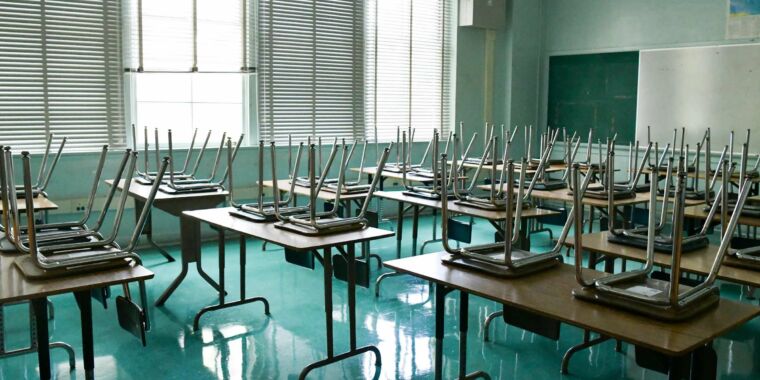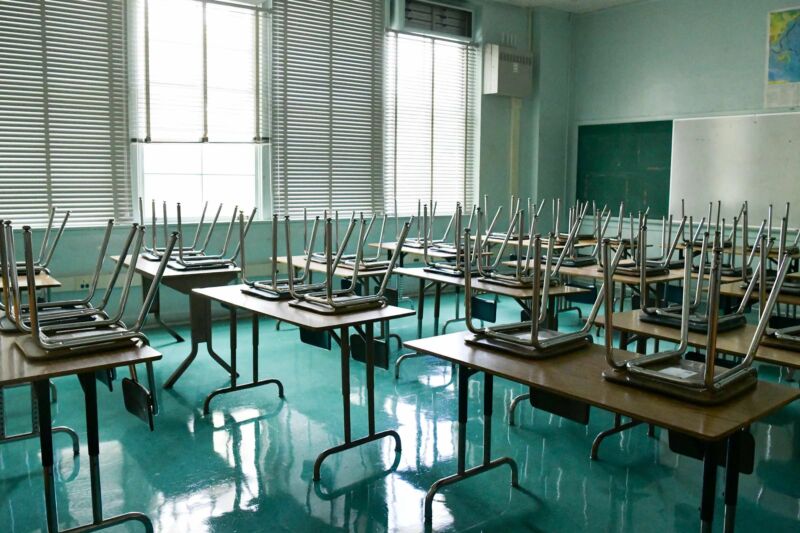
Removing incorrect claims–.
Claims they get rid of 99%of infections are unverified; less expensive air filters are more reliable.

Robin Eckenroth|Getty Images
Last fall, Jeff Kreiter, director of functional services for the school district in Sioux Falls, South Dakota, discovered himself flooded with propositions to clean up the air inside class. The concepts differed– UV lights, air exchangers, a large selection of filters– however one looked particularly appealing: a bipolar ionizer. The system included a set of amazed tubes, positioned in duct, that would flood the structures with charged particles, or ions. Marketing products from the business AtmosAir guaranteed that this would get rid of toxins and infections by imitating the ion-rich air discovered in an alpine town. The district paid a regional supplier $2 million to set up the system in 33 school structures. “Eventually we wished to eliminate the infection and have a much healthier environment, however we desired this long-lasting and not simply for corona,” Kreiter states.
The science behind those ion-producing tubes checks out like a sophisticated example from a high school book. The ions are suggested to cause what chemists call “coagulation.” Like blood cells thickening an injury, particles of opposite charge glom together, catching nasty things that you do not desire in your lungs, like pollen and mold. Ultimately, those clumps grow big enough that gravity takes control of and they fall harmlessly to the ground. With infections, there’s another advantage: the ions gum up surface area proteins utilized to go into cells, making them less efficient intruders. The outcome, and the banner claim made in the business’s pitch to schools throughout the pandemic, is a 99.92 percent decrease in coronavirus within 30 minutes.

The issue, according to air-quality professionals, is that there’s little independent proof to support such claims. Air cleaners are mainly self-regulated, with couple of requirements for how makers ought to check their items, and peer-reviewed research study is little. The science might operate in concept or in a regulated laboratory test, however how well ionization cleans up a class’s air is a various story. Claims associated with COVID-19 are specifically suspicious. Many air-cleaner makers, consisting of AtmosAir, depend on regulated tests that show how ionization removes infections discovered on surface areas, which has little bearing on how well ions clarify.
Annoyed air-quality researchers state the market is making a play for funds that ought to go to easier, tested enhancements to school ventilation. “None of these gadgets have actually been shown to work,” states Delphine Farmer, a climatic chemist at Colorado State University who has actually studied ionization innovation. “Anybody who comprehends the chemistry would state you must be extremely careful of utilizing them.”
A larger issue, she includes, is the capacity for air-cleaner gadgets to do damage. Ionizers in specific have a history of producing by-products, consisting of ozone, formaldehyde, and other unstable substances, that can harm the lungs. Tests of AtmosAir’s ionizer by the New york city State Department of Health discovered raised levels of ozone in class where it was running. The business disagreements those findings and indicate market accreditations that its innovation is ozone-free.
However air cleansing is now in style in schools, which are flush with federal financing to resume securely and are poised to get far more. Lots of districts have actually acquired ionizers utilizing Cares Act financing, along with other chemical air-cleaning treatments. After a general search, Marwa Zaatari, an air-quality expert in Austin, Texas, put together a list of purchases amounting to about $60 million. The American Rescue Strategy just recently authorized by Congress consists of an extra $122 billion in school help, stiring optimism amongst air-cleaner makers and suppliers. “It feels so beating that after this unexpected awakening to the significance of indoor air quality, all the cash is being put towards unverified innovation,” Zaatari states.
The very best methods to enhance indoor air quality depend upon the area, however the majority of professionals indicate reasonably basic options such as opening windows and setting up physical filters that fulfill screening requirements established by companies such as the American Society of Heating, Refrigerating, and Air-Conditioning Engineers, or ASHRAE. The acronyms for those requirements, such as MERV and HEPA, get a little complicated, however they show what sort of particles they can filter out and at what rate. MERV-13 filters, which the Centers for Illness Control and Avoidance state work for straining aerosols of the size that might harbor SARS-CoV-2, choose about $25 A school might require lots of filters and possible upgrades of ventilation systems if they can’t require adequate air through the less-porous filters.
The makers of ionizers contest that their innovation is unverified. Tony Abate, the primary innovation officer of Clean Air Group, AtmosAir’s business name, states conventional filtering approaches need ventilation systems that efficiently distribute air through the filters, which some areas do not have. By contrast, ions that are distributed throughout a structure handle pollutants, like infections, at the source of a sneeze or cough. Preferably, he states, schools ought to embrace a combined technique. “It’s a layer of security. It’s not implied to change other layers. It is essential that you utilize filters and aerate your structures which you manage your sources with masks and handwashing,” he states. He indicates commissioned laboratory research studies and case research studies from clients who have actually seen their air quality enhance.
Kreiter, of Sioux Falls schools, where trainees have actually been discovering personally considering that last fall, states authorities are pleased with their air quality up until now. One inform was the absence of problems with mold this year, a typical issue throughout the winter season. He acknowledged it was hard to inform whether the enhancements were due to ions drifting throughout the schools or the outcome of enhanced air filters, which were acquired individually and set up at approximately the exact same time.
Air cleaners slip through the regulative fractures. They’re not medical gadgets, so the Fda does not evaluate them. The Epa does not manage indoor air quality beyond particular dangerous by-products. The CDC describes air cleaners as “emerging innovations” and recommends purchasers “do their research” on producers’ claims. ASHRAE uses comparable equivocation, keeping in mind the absence of “persuading, clinically extensive, peer-reviewed research studies” on the innovation. Simply put, purchaser beware. That leaves schools learning an alphabet soup of unknown acronyms and producer claims as they hurry to utilize funds to resume securely.
Those characteristics are not distinct to air cleaners. Other popular post-COVID school upgrades, like contactless temperature level screeners, fall under a comparable gray location in regards to marketing and guideline. A research study group last month reported that lots of makers had actually set them to show just “regular” temperature level readings. School authorities and suppliers informed WIRED that the advantages of the thermometers were mainly mental.
For air cleaners, the struggling history precedes COVID-19 They have actually generally been offered as a method to enhance indoor air quality without compromising energy effectiveness, making them a favorite of green structure designers. Rather of presenting outside air, which requires to be warmed or cooled, they enable structures to be sealed more firmly while the ions flow within. Products like Sharper Image’s Ionic Breeze, a staple of early 2000 s brochure culture, have actually assisted offer the market a premium shine. The issue, as Customer Reports discovered when it checked the Ionic Breeze, was that ionization didn’t do much to get rid of toxins however produced great deals of ozone. (Lawsuits over the gadget later on assisted send out Sharper Image into personal bankruptcy defense)
Without basic screening approaches, it can be a difficulty for nonexperts to assess claims about a specific gadget. Efficiency will depend upon numerous elements of the screening, like how the toxin was presented, the size and ventilation of the area, and how extremely the ionizer ran. Another problem is just how much credit it is worthy of for clarifying in the middle of other aspects. A maker may declare that an ionizer gets rid of 99.9 percent of a specific contaminant over a set amount of time, however was it actually the ionization, or was it a mix of standard filtering and natural decay? And did it get rid of the toxin from the air or off of a surface area? “I do not blame schools when they’re attempting to decide, due to the fact that the reports are really complicated, and it’s simple to be tricked,” Zaatari states.
A single passage of a space’s air through a MERV-13 filter will get rid of a minimum of 85 percent of extremely great aerosols, discusses Kathleen Owen, an air-quality engineer and member of ASHRAE’s epidemic job force. Sounds a lot even worse than 99.9 percent. In a well-ventilated area, air might pass through a filter a number of times within minutes. “It discomforts me to see schools purchasing something I can’t state really works,” Owen states. “I actually, truly wish to see more information out there.”
Just Recently Farmer, the Colorado State scientist, together with coworkers at Illinois Tech and Portland State University, put one ionizer to an uncommon independent test They evaluated a “needlepoint bipolar ionization” gadget, especially popular with schools, consisting of 4 districts in the Lehigh Valley of Pennsylvania which jointly invested $1.3 million to install them, according to The Early morning Call in Allentown. (The pitch from a regional salesperson likewise stressed mountaintop air.) In tests in both regulated settings and those suggested to mirror real-world areas, the scientists discovered that the gadget produced a minimal quantity of ozone, which was a good idea. The ionization had little effect on particles drifting in the air and was discovered to have a disadvantage: it produced other unstable substances consisting of acetone and toluene, irritants that can trigger lung and nerve damage with persistent direct exposure. The science may be stylish, however in a real-world area there’s simply inadequate charge and insufficient air streaming for the ions and coagulation to make much of a distinction, Farmer states.
Worldwide Plasma Solutions, the business that makes the gadget, challenges the findings of the tests, which it states did not show standard procedure and needed more duplication. A representative for the business directed WIRED to research study commissioned by the business revealing the innovation reduced the effects of SARS-CoV-2 on surface areas and aerosols in laboratory settings, in addition to case research studies from clients consisting of universities and the White Home.
Farmer acknowledges that her group ran just one set of experiments on a single gadget. “I didn’t enter into science to pursue particular producers,” she states. She prefers federal government guideline, or a minimum of a clearer set of requirements by which makers need to carefully evaluate their items and provide their information to consumers. That’s the function of a body like ASHRAE. The pandemic has actually offered more seriousness to come up with requirements, and members are dealing with them, however Owen states the procedure might take years.
In the meantime, Zaatari has an easy message for school administrators and moms and dads calling her for guidance: adhere to the fundamentals. “It’s so inexpensive to utilize present tested innovations,” she states. “There’s a lot false information.”
This story initially appeared on wired.com
No comments:
Post a Comment